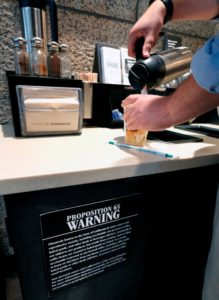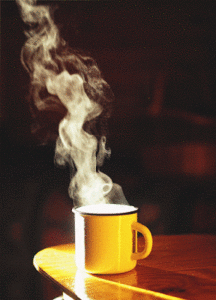A judge’s ruling on warning labels for coffee isn’t backed by evidence and could do more harm than good.
 About two-thirds of smokers will die early from cigarette-based illnesses. Cigarettes are also very addictive. Because of this, it seems reasonable to place warnings on their labels.
About two-thirds of smokers will die early from cigarette-based illnesses. Cigarettes are also very addictive. Because of this, it seems reasonable to place warnings on their labels.
If a Los Angeles Superior Court judge has his way, California businesses will have to put similar warnings on something else that can be addictive, coffee. His ruling, which is being challenged by coffee producers, is harder to justify in terms of health — if it can be justified at all.
California’s Proposition 65, enacted in 1986, mandates that businesses with more than 10 employees warn consumers if their products contain one of many chemicals that the state has ruled as carcinogenic. One of these chemicals is acrylamide. Like many other substances, acrylamide causes cancer in rats — when they are pumped full of huge doses in ways that don’t approximate real life.
In humans, the data are far less clear. The American Cancer Society (which does not shrink from saying things cause cancer) reports on its website that “there are currently no cancer types for which there is clearly an increased risk related to acrylamide intake.”
Other organizations, such as the International Agency for Research on Cancer, have warned that acrylamide is a “probable human carcinogen.” But this is based almost entirely on animal studies, and the agency has backpedaled in recent years. It’s also worth pointing out that of the nearly 1,000 substances the agency has classified, it has ruled almost none to be non-carcinogenic.
Regardless, acrylamide isn’t an industrial additive. It’s a chemical that is made almost any time you cook starches at temperatures above 250 degrees Fahrenheit. You can make acrylamide from frying, baking, broiling or roasting — essentially anything that isn’t boiling or microwaving.
Toasted bread contains acrylamide. So do fried and roasted potatoes. So do roasted coffee beans. Acrylamide formation occurs whether this cooking is done by a corporation or by you in your home. It’s made even when you cook organic food — there’s just not much of a way to avoid it. Acrylamide is found in about 40 percent of the calories consumed by people in the United States.

A Starbucks shop in Los Angeles. Some coffee retailers already have warning messages.
CreditRichard Vogel/Associated Press
Some California businesses that serve food and drinks, unwilling to wage a legal fight against Proposition 65 or possibly hedging against fines, have already posted warnings about acrylamide over the years. A handful of makers of potato chips and fries also agreed to reduce their levels of acrylamide by 20 percent. There have been no studies showing this has made any difference in health, certainly not with respect to cancer.
Coffee has had acrylamide in it since humans started drinking it. The Food and Drug Administration, in its Guidance for Industry Acrylamide in Foods, reports that there is no viable commercial process for making coffee without producing at least some acrylamide.
If there were such a process, there wouldn’t be a reason to use it. After all, we have a wealth of evidence about coffee’s effects. Meta analyses have shown that coffee is associated with lower risks of liver cancer, and no increased risk of prostate cancer or breast cancer. When we look at cancer over all, it appears that coffee — if anything — is associated with a lower risk of cancer.
Even the International Agency for Research on Cancer has essentially reversed itself. In 2016, it declared that “drinking coffee was not classifiable as to its carcinogenicity to humans.”
The more serious problem with California’s law is one of effect size. Health, and cancer, aren’t binary. Consumers can’t just be concerned with whether a danger exists; they also need to be concerned about the magnitude of that risk. Even if there’s a statistically significant risk between huge quantities of coffee and some cancer (and that’s not proven), it’s very, very small.
Cigarettes have a clear and easily measured negative impact on people’s health. Acrylamide, especially the acrylamide in coffee, isn’t even close.
Warning labels should be applied when a danger is clear, a danger is large and a danger is avoidable. It’s not clear that, with respect to acrylamide, any of these criteria are met. It’s certainly not the case regarding coffee. Whatever the intentions of Proposition 65, this latest development could do more harm than good.

A Trip to California
In 1994, a systematic review in The Journal of Public Policy and Marketing on the unintended consequences of warning messages said, “The emphasis of policymaking in the past has tended to focus more on the identification of potential hazards than on helping consumers develop an understanding of the magnitude and probability of a potential hazard that can be used for informed decision making.”
If Americans slap a label on every substance that has the potential to cause cancer, eventually those labels will stop having any meaning. If nearly inconsequential dangers get the same warning as significant dangers, people might start ignoring preventive efforts entirely.
Written by Aaron E. Carroll and published by The New York Times ~ April 23, 2018.
~ RELATED ~
* How three cups of coffee a day can extend your life
* 10 Things Coffee Does FOR Your Body
* Coffee really CAN help to prevent dementia
* How coffee could help fight bowel cancer
* How coffee could help fight bowel cancer
So – just who are we supposed to believe, Jerry Brown and the Demagogues in California? Do your own studies – then get out of the ‘Golden State’. ~ Ed.
 FAIR USE NOTICE: This site contains copyrighted material the use of which has not always been specifically authorized by the copyright owner. We are making such material available in our efforts to advance understanding of environmental, political, human rights, economic, democracy, scientific, and social justice issues, etc. We believe this constitutes a ‘fair use’ of any such copyrighted material as provided for in section 107 of the US Copyright Law. In accordance with Title 17 U. S. C. Section 107, the material on this site is distributed without profit to those who have expressed a prior interest in receiving the included information for research and educational purposes. For more information go to: http://www.law.cornell.edu/uscode/17/107.shtml“
FAIR USE NOTICE: This site contains copyrighted material the use of which has not always been specifically authorized by the copyright owner. We are making such material available in our efforts to advance understanding of environmental, political, human rights, economic, democracy, scientific, and social justice issues, etc. We believe this constitutes a ‘fair use’ of any such copyrighted material as provided for in section 107 of the US Copyright Law. In accordance with Title 17 U. S. C. Section 107, the material on this site is distributed without profit to those who have expressed a prior interest in receiving the included information for research and educational purposes. For more information go to: http://www.law.cornell.edu/uscode/17/107.shtml“
